Efficiency question, gasser vs. cat?
- Thread starter BillsWS
- Start date
-
Active since 1995, Hearth.com is THE place on the internet for free information and advice about wood stoves, pellet stoves and other energy saving equipment.
We strive to provide opinions, articles, discussions and history related to Hearth Products and in a more general sense, energy issues.
We promote the EFFICIENT, RESPONSIBLE, CLEAN and SAFE use of all fuels, whether renewable or fossil.
You are using an out of date browser. It may not display this or other websites correctly.
You should upgrade or use an alternative browser.
You should upgrade or use an alternative browser.
- Status
- Not open for further replies.
Highbeam
Minister of Fire
All of the top three highest efficiency stoves are cat stoves. Maybe more but non-cats are decidedly not as efficient. In the real world, it's not that important but in theory, non-cats waste wood.
Of course we must define efficiency as total efficiency meaning total input energy minus what goes up the stack to waste. With conservation of energy, anything that doesn't go up the stack MUST go into the home.
Of course we must define efficiency as total efficiency meaning total input energy minus what goes up the stack to waste. With conservation of energy, anything that doesn't go up the stack MUST go into the home.
Backwoods Savage
Minister of Fire
Hey Bill, you aren't shopping for another stove are you? Looking at your present temperature and the forecast, maybe you need it fast! 

Yes, rdust, gassification boiler with storage compared to say a Blaze King Sirocco 30. Yeah Dennis, the house I just moved into has in-floor heat so I think it would be an ideal set-up for a boiler. With a boiler the basement floor, main floor and DHW could all be supplied but the money difference in the two is a consideration. The house is ICF with propane on-demand heaters supplying the DHW and in-floor heat. I don't want the boiler in my basement so the expense of a seperate boiler and wood storage building, the boiler, piping, etc... compared to a new class A chimney and BK in the living room is significant. I was looking to justify my decision one way or the other by looking at which is the most efficient, boiler vs cat.
I'd have to think a gasification boiler would be more efficient if burned as hot as possible, then utilizing storage but there would have to be a calculation of installation costs (holy crap, I wouldn't even want to think about it with the boiler and storage) and payoff time. The Sirocco is smaller than my BK Princess, so I figure your home isn't that large. So a smaller home doesn't necessitate a boiler to evenly heat the place. Along with installation costs, is there any benefit to you with sitting and watching the fire vs. the boiler? Also, what are the chances something will break with the boiler vs. the stove? (More moving parts with the boiler) And what are the chances that you can fix what is broken on a boiler vs. stove? GL with either purchase!
Highbeam
Minister of Fire
I apologize for bringing up non-cats. I never would have thought that you were comparing the efficiency of a gasification boiler to a catalytic woodstove. That is a tough comparison because the two devices have different functions. It's like comparing a diesel dump truck to a gas lawnmower.
In any case, I would want both a stove and a boiler. You already know your stoves so now to choose the boiler.
The sirocco30 is almost exactly the same size as the princess with similar performance and cleaner emissions.
In any case, I would want both a stove and a boiler. You already know your stoves so now to choose the boiler.
The sirocco30 is almost exactly the same size as the princess with similar performance and cleaner emissions.
Yes, rdust, gassification boiler with storage compared to say a Blaze King Sirocco 30.
If I ever get my pole barn built I will have my eye on a gasser with storage so I can heat the house, garage and out building. Until that happens the payback on a gasser set up just isn't there for me. I have no proof one way or the other but I would think a gasser running full out once or twice a day to heat the storage is more efficient than the stove but I've been wrong before.

Edit: If you're trying to heat a large home the gasser would also be the way to go imo
I shall retract my smart@ss comment, but I'm keeping the popcorn, because that's interesting.
The ICF contruction seems like it would make the ROI on a complete boiler setup pretty far out there. Any idea what the previous owners were paying for heat?
Personally, I really enjoy warming my backside in front of a stove. I don't know if you can do that laying on a warm floor.
The ICF contruction seems like it would make the ROI on a complete boiler setup pretty far out there. Any idea what the previous owners were paying for heat?
Personally, I really enjoy warming my backside in front of a stove. I don't know if you can do that laying on a warm floor.
I shall retract my smart@ss comment, but I'm keeping the popcorn, because that's interesting.
The ICF contruction seems like it would make the ROI on a complete boiler setup pretty far out there. Any idea what the previous owners were paying for heat?
Personally, I really enjoy warming my backside in front of a stove. I don't know if you can do that laying on a warm floor.
I called the propane company and they gave me a dollar amount for the year at $1700. The house is 2000 sq. ft. main floor, 2000 sq. ft. basement. At closing it was determined that there was 50% (approx $500) still in the propane tank so I was thinking actual usage then was around $1200 for the year? Does that seem about right? I think the price per gallon was $1.77 - $1.80 range. My probable course of action is to investigate boilers (U.P. State Fair this week, I know Garn is there and the Great Lakes Logging Congress in Sept, I know Portage and Main and Econoburn will be there), install the BK for this year and just see how that goes for now. I like the idea of having a boiler heat both floors and all the zones, but funding the idea is another thing all together. I may end up with a less efficient set-up (like the P&M BL 28-40 OWB) due to cost considerations. Still climbing the learning curve and appreciate the information/education I am getting here.
Bster13, those are all good points you make. Seeing the fire, sitting in front of the stove, the up front costs and even having the stove function during a power outage without running a backup generator make me lean in that direction. Will probably end up with both but I don't see how I can justify the extra cost of the gasser and storage.
Highbeam
Minister of Fire
I gotta say, this would be a great question for the boiler room guys. Most of us don't have experience with water heat.
aansorge
Minister of Fire
There is someone on here that has done it all....and he is back to a regular wood burning stove. They are simple, cheap, and effective.
Wood gasification boilers require dry wood just like modern stoves. Some of the other types of OWB can get by on wetter wood and some people will take the decrease in efficiency to be lazier with their wood supply. This is all coming from a guy who has never owned an outside wood burner, so take it with a grain of salt.
Wood gasification boilers require dry wood just like modern stoves. Some of the other types of OWB can get by on wetter wood and some people will take the decrease in efficiency to be lazier with their wood supply. This is all coming from a guy who has never owned an outside wood burner, so take it with a grain of salt.
Clarkbug
Minister of Fire
Coming from the boiler camp (lurking over here in the other forums...) I can offer my input. (Note: I dont claim that any of it will be useful  )
)
Your new house sounds like its the ideal setup for a gasser with storage. The in-floor can take a low water temp and still keep you comfortable, as well as provide your DHW needs. With a moderately sized store of water, you would only need to fire every few days, especially with your well insulated house. You could even look into solar thermal options (if your site is set up that way) which could provide a lot of energy into the storage for "free" all year long.
Personally, I would LOVE to have a woodstove in the house. Nothing beats that kind of heat when the chill is just in your bones, and it works without power. Radiant floor heat is also pretty awesome. Having warm feet all the time without having to open the windows because you are too warm is also pretty awesome.
In your case, are the lines in the floor filled with Glycol? You would still want a generator for an extended outage just to run the circulator pumps to prevent freezing.
I would say that if you would have to build a boiler barn, its probably going to push your limits on finances, but then again it could have a lot of uses when doubling as a woodshed/man cave. Also, Garn just came out with the Garn Jr. which is a little more reasonable in size for smaller residential loads, and that might be a consideration, since the storage is built right in.
I would say go for a wood stove while you think about the boiler.
 )
)Your new house sounds like its the ideal setup for a gasser with storage. The in-floor can take a low water temp and still keep you comfortable, as well as provide your DHW needs. With a moderately sized store of water, you would only need to fire every few days, especially with your well insulated house. You could even look into solar thermal options (if your site is set up that way) which could provide a lot of energy into the storage for "free" all year long.
Personally, I would LOVE to have a woodstove in the house. Nothing beats that kind of heat when the chill is just in your bones, and it works without power. Radiant floor heat is also pretty awesome. Having warm feet all the time without having to open the windows because you are too warm is also pretty awesome.
In your case, are the lines in the floor filled with Glycol? You would still want a generator for an extended outage just to run the circulator pumps to prevent freezing.
I would say that if you would have to build a boiler barn, its probably going to push your limits on finances, but then again it could have a lot of uses when doubling as a woodshed/man cave. Also, Garn just came out with the Garn Jr. which is a little more reasonable in size for smaller residential loads, and that might be a consideration, since the storage is built right in.
I would say go for a wood stove while you think about the boiler.
Huntindog1
Minister of Fire
Thursday, May 30, 2013
EPA Requests Outdoor Boiler Companies to Remove Disputed Efficiency Ratings
On May 9, the EPA sent letters to manufacturers of outdoor boilers (aka outdoor hydronic heaters) requesting that they remove efficiency information for EPA qualified models tested with EPA’s previous Method 28 OWHH from websites and all printed materials. The EPA sent them new hangtags without efficiencies to replace the old ones.
The letters, signed by Gregory Green, Director of the Outreach and Education Division, asked that this be done by June 14, giving companies about 7 weeks to comply. The companies are also asked to inform their retailers to discontinue use of the old hangtags and printed materials using the old efficiency numbers.
The EPA’s move to stop the use of those discredited efficiency numbers was welcomed by the Alliance for Green heat and many state agencies and industry members.
The request is the latest twist in a voluntary program that called into question both the EPA’s credibility to test efficiency and the boiler companies who continued to use the impossibly high numbers. It also gave a significant marketing edge to outdoor boilers who could claim far higher efficiencies than wood and pellet stoves and automated European boilers. Outdoor boilers tested under the previous EPA approved test method were reporting efficiencies of up to 97%.
The EPA removed the efficiency numbers from their website in 2011 and requested manufacturers to stop using them. Manufacturers reportedly balked, saying they wouldn’t stop using the high efficiency numbers until their competitors stopped.
Today, it is unclear how efficient Phase 2 outdoor boilers actually are. According to a paper from Intertek, one of the leading wood stove test labs: “With the exception of a number of test reports indicating impossibly high efficiencies, the weighted average efficiencies of appliances meeting EPA Phase II emissions limits average 55%.” The State of Maine gives an estimate of 65% efficient to Phase 2 outdoor boilers on its fuel calculator and 55% for unqualified boilers.
Related stories: http://biomassmagazine.com/articles/5468/epa-biomass-boiler-industry-proposed-emissions-rules-arenundefinedt-flying-at-the-state-level
EPA, Biomass Boiler Industry Proposed Emissions Rules Aren’t Flying at the State Level
By Scott Nichols | April 29, 2011
In 2007, responding to a need to reduce emissions from Outdoor Hydronic Heaters, then known as outdoor water stoves, EPA began a Voluntary Hydronic Heater Emission Testing Program. The EPA, states, industry and other parties came together to solve a burgeoning smoke problem. The program began with Phase I, which would certify units at a 70 percent cleaner emission level on average than industry had been providing before federal and state involvement. Phase II certified units would be approximately 90 percent cleaner than the average prevoluntary program products. Today EPA is transitioning from a voluntary hydronic heater testing program to a mandatory program. This program will include all indoor and outdoor biomass boilers.
The process has been slow moving. Recently the EPA program stumbled. In early 2011, EPA abruptly removed from its Burn Wise website all efficiency numbers for Phase II approved hydronic heaters.
With efficiency numbers for log wood hydronic heaters reported in the dubiously high, upper 90 percent range, regulators and others became suspicious of test accuracy. While there is speculation as to why the EPA-approved efficiency numbers were so high, a single smoking gun has not been found. Partially as a result of EPA testing problems, on March 15, Oregon declared a moratorium, among other enforcement actions, on all new installations of hydronic heaters and several other wood-burning appliances (see www.oregon.gov/DEQ and search Heat Smart).
All parties to the matter now find themselves in a scramble to not only find where the EPA test went wrong, but to also create an updated suite of tests that are relevant to a broader range of biomass boiler technology. The EPA has targeted June for publication of a draft Residential New Source Performance Standard for wood-burning appliances. As this target looms, Oregon’s action sends a clear signal to both EPA and industry that not only must they move quickly, but also move accurately.
Behind the scenes EPA and industry, including members of the Biomass Thermal Energy Council are working feverishly through the ASTM process and other means to create test methods with an efficacy that all parties can agree to. Test methods are being debated and written, but there is little time or money to perform trial testing. What is clear is that even if methods are completed on paper, there will be little proof that new test methods are compatible and accurate with all appliances. It is uncertain whether test results that satisfy the likes of Oregon are possible in the foreseeable future.
Industry, states and the EPA have dug a deep hole on the hydronic heater emission issue. Industry has dragged its feet. Manufacturers of outdoor water stoves have moved slowly to cleaner units. One result is that smoke-belching outdoor water stoves have become a symbol for wood heating in general. Meanwhile, many companies with cleaner technology that could have contributed to a solution stayed silently on the sidelines hoping for a favorable outcome. The New York State Energy Research and Development Authority has been actively pursuing solutions, but many states have been more reactive than constructive. The result is that as energy prices rise, especially heating oil prices, citizens of states like Oregon have fewer alternative heating options. Meanwhile, the EPA is not only learning about all of the technology available, but is also filtering and reconciling federal and state requirements with wants and needs of industry, environmentalists, health groups and others.
The one-size-fits-none Oregonian approach is a clear sign that there is much work to do. The EPA plans to publish its final residential NSPS Rule in 2012 and has presented 2013 or 2014 as a final deadline for compliance. It is imperative that all sectors come together to solve the hydronic heater emission testing problem. The eventual result must be a sea change from the average type of hydronic heater that is sold today. Hydronic heaters sold in the future must be authentically highly efficient and must be sold with a test report that is easily understood and trusted by consumers. The era of selling wasteful hydronic heaters/biomass boilers is over. Oregon has helped make sure of that.
Author: Scott Nichols
Director, BTEC and President, BioHeatUSA
www.biomassthermal.org
C
charly
Guest
Been there , done that... EKO 60, 1500 gallons of thermal storage,, moved to a another home, back to a wood cook stove and Woodstock Progress Hybrid.... Power goes out you don't have to worry about circulators.. I say keep it simple... I burn half the wood I use to using a couple of wood stoves, plus I get to watch the fire and cook my food at the same time... Yup a little wood mess in the house, that's what dust pans and vacuums are for. I had a lot of money tied up into pipe for the ground, thermal storage, the boiler , chimney, two expansion tanks, plus a good size insulated building ... I'll take a wood stove any day and never look back...
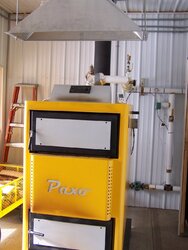
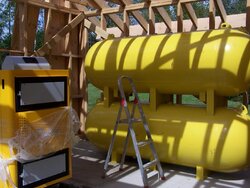
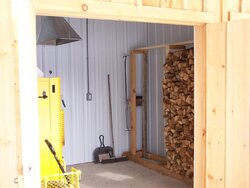
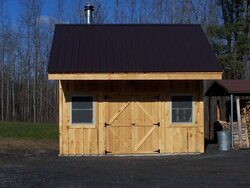
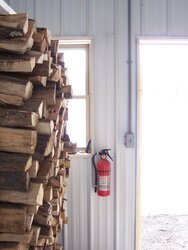





Dan Rondeau
New Member
- Aug 18, 2012
- 13
I have an econoburn 150 for sale in connecticut. BRAND NEW!!
https://www.hearth.com/talk/threads/econoburn-150-brand-new.109661/
https://www.hearth.com/talk/threads/econoburn-150-brand-new.109661/
I have an econoburn 150 for sale in connecticut. BRAND NEW!!
https://www.hearth.com/talk/threads/econoburn-150-brand-new.109661/
Every post you have made is about selling something?
Coog
Burning Hunk
Charley, your explanation really tells the story and proves what I decided 4 years ago. The only real hang up I had was insurance. The insurance companies do not care about outdoor boilers a long as they are a certain distance from the house. The indoor wood stoves they ask a few more questions and could charge a premium.
There is also a much more equally spread heat with an outdoor boiler if you use radiant piping. Some tie to the furnace and install a heating coil. The outdoor, non gasification boilers, are wood hogs. I do not have the time it takes to feed those animals. I have two brother in laws with those things and all they do is cut wood. I bet 8 to 10 cords a year for each.
Probably 10k if you do a lot of the work yourself and you will still use more wood, even with the gasification. But maybe not, some of those guys in the boiler forum have gotten it down to a science. I just couldn't get there.
There is also a much more equally spread heat with an outdoor boiler if you use radiant piping. Some tie to the furnace and install a heating coil. The outdoor, non gasification boilers, are wood hogs. I do not have the time it takes to feed those animals. I have two brother in laws with those things and all they do is cut wood. I bet 8 to 10 cords a year for each.
Probably 10k if you do a lot of the work yourself and you will still use more wood, even with the gasification. But maybe not, some of those guys in the boiler forum have gotten it down to a science. I just couldn't get there.
- Status
- Not open for further replies.
Similar threads
- Replies
- 17
- Views
- 987
- Replies
- 1
- Views
- 717
- Replies
- 8
- Views
- 2K
- Replies
- 8
- Views
- 1K
- Replies
- 1
- Views
- 769


